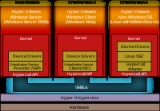
Hyper-V
Overview
Hypervisor
In computing, a hypervisor, also called virtual machine manager , is one of many hardware virtualization techniques that allow multiple operating systems, termed guests, to run concurrently on a host computer. It is so named because it is conceptually one level higher than a supervisory program...
-based virtualization system for x86-64
X86-64
x86-64 is an extension of the x86 instruction set. It supports vastly larger virtual and physical address spaces than are possible on x86, thereby allowing programmers to conveniently work with much larger data sets. x86-64 also provides 64-bit general purpose registers and numerous other...
systems. A beta version of Hyper-V was shipped with certain x86-64 editions of Windows Server 2008, and the finalized version (automatically updated through Windows Update
Windows Update
Windows Update is a service provided by Microsoft that provides updates for the Microsoft Windows operating system and its installed components, including Internet Explorer...
) was released on June 26, 2008. Hyper-V has since been released in a free stand-alone version, and has been upgraded to Release 2 (R2) status.
Hyper-V exists in two variants: as a stand-alone product called Microsoft Hyper-V Server 2008, and as an installable role in Windows Server 2008 R2
Windows Server 2008 R2
Windows Server 2008 R2 is a server operating system produced by Microsoft. It was released to manufacturing on July 22, 2009 and launched on October 22, 2009. According to the Windows Server Team blog, the retail availability was September 14, 2009. It is built on Windows NT 6.1, the same core...
and Windows Server 2008 (the former containing the later release of Hyper-V).
The stand-alone version of Hyper-V is free, and was released on October 1, 2008.

